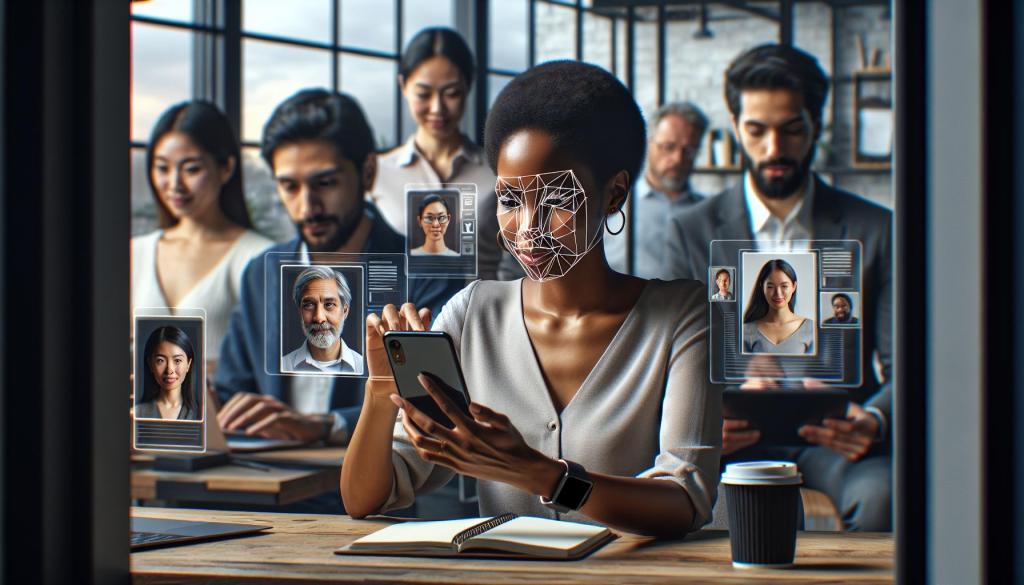Updated: Jul 05, 2024 By: Marios

In today's digital age, identity verification has become more crucial than ever. Enter FaceCheck ID, a cutting-edge technology that's transforming how we confirm identities online. It's not just about convenience—it's about enhancing security in a world where cyber threats are constantly evolving.
I've delved into the mechanics of FaceCheck ID and found it fascinating how it uses advanced facial recognition algorithms to authenticate users. This technology doesn't just recognize faces; it learns and adapts, making it a robust tool for businesses and individuals alike. Whether you're curious about its applications or its impact on privacy, understanding FaceCheck ID is essential for navigating our increasingly digital world.
What Is FaceCheck ID?
FaceCheck ID is a sophisticated identity verification tool using advanced facial recognition technology to ensure secure authentication for users.
Overview of FaceCheck ID
FaceCheck ID elevates digital security with its innovative abilities. It employs deep learning algorithms to analyze and match facial features app. By providing quick and accurate identification, it prevents unauthorized access and reduces fraud.
How FaceCheck ID Works
FaceCheck ID operates in several stages. Initially, it captures the user's facial image through a camera. It then converts this image into a digital template, extracting unique facial points. The system compares these points with stored data to confirm identity. If there's a match, the user gains access to the intended service, ensuring only authorized individuals proceed.
Ultimately, FaceCheck ID enhances the security and reliability of digital interactions by leveraging cutting-edge facial recognition algorithms.
Key Features of FaceCheck ID

FaceCheck ID offers several robust features app to enhance identity verification. Among these, two significant capabilities are facial recognition and database management.
Facial Recognition Capabilities
FaceCheck ID excels in facial recognition. It uses advanced deep learning algorithms to analyze and authenticate users. The system captures a user's facial image, converts it into a detailed digital template, and matches this against stored data. This process ensures quick and accurate identification, preventing unauthorized access and reducing fraud.
Database and Image Indexing
FaceCheck ID boasts an extensive database coupled with efficient image indexing. The system stores and organizes vast amounts of facial data, allowing for rapid comparisons. This database is continuously updated, ensuring the most recent and accurate information is always available. By maintaining indexed images, FaceCheck ID swiftly identifies individuals, enhancing overall security and reliability in digital interactions.
Practical Applications of FaceCheck ID

FaceCheck ID offers a range of applications that enhance both personal and commercial security. Understanding its use cases helps appreciate its capability to transform identity verification.
Individual Use Cases
FaceCheck ID simplifies personal security by integrating biometric authentication in everyday activities. For instance:
- Smartphone Security: Users unlock devices using facial recognition, reducing the risk of unauthorized access.
- Online Banking: Facial recognition ensures secure logins and transactions, protecting sensitive financial information.
- Travel: Airports use FaceCheck ID for quicker check-ins and boarding, enhancing travel convenience and security.
Business Applications
Businesses leverage FaceCheck ID to fortify security and streamline operations. Common business implementations include:
- Employee Verification: Companies use facial recognition to manage employee access to facilities, ensuring only authorized personnel enter restricted areas.
- Customer Authentication: Banks and financial institutions use facial ID for secure client verification during account setups and online banking sessions.
- Event Management: Event organizers expedite attendee check-ins by using facial recognition systems, reducing wait times and enhancing security.
These applications showcase the versatile nature of FaceCheck ID, making it a vital solution in the digital age.
Pros and Cons of Using FaceCheck ID
FaceCheck ID offers significant benefits but also comes with certain limitations. Evaluating these aspects can help users make informed decisions.
Advantages of FaceCheck ID
FaceCheck ID enhances security. By using advanced facial recognition algorithms, it ensures that only authorized users can access personal or sensitive information. This is particularly beneficial for applications like smartphone security, online banking and employee verification.
FaceCheck ID improves efficiency. Automated identity verification reduces the need for manual checks, speeding up processes in various settings. Businesses can streamline customer authentication while individuals can enjoy quicker access to their devices and accounts.
FaceCheck ID supports fraud prevention. The robust database used in facial recognition helps in accurately identifying individuals, minimizing the risk of identity theft. This is crucial for maintaining the integrity of financial transactions and personal data security.
Limitations and Concerns
FaceCheck ID raises privacy concerns. Since facial data is stored in databases, there's a risk of unauthorized access or misuse. Users might worry about how their biometric information is handled and who has access to it.
FaceCheck ID can be less effective in certain conditions. Environmental factors, like poor lighting or changes in appearance, can impact the accuracy of facial recognition. This may lead to false rejections, requiring alternative verification methods.
FaceCheck ID involves implementation costs. Setting up and integrating facial recognition systems can be expensive, especially for small businesses. This initial investment might deter some organizations from adopting the technology.
Evaluating these pros and cons allows users to decide if FaceCheck ID meets their security needs effectively.
Ethical and Privacy Considerations

FaceCheck ID leverages facial recognition to enhance security. However, it's crucial to discuss ethical and privacy considerations.
Data Privacy and User Consent
FaceCheck ID collects biometric data, which raises privacy concerns. Users must give explicit consent before data collection begins. Companies should implement transparent policies outlining data usage. Data storage security is critical; encrypted storage reduces unauthorized access risks. Only necessary data should be collected to minimize potential breaches. Users should be informed of their rights to access and delete their data.
Ethical Implications of Facial Recognition
Facial recognition introduces ethical challenges. Bias in algorithms can lead to discriminatory practices. Developers need diverse datasets to ensure accuracy across demographics. Misuse of technology by unauthorized parties poses significant risks. Regulations should guide ethical use, enforcing penalties for violations. Continuous monitoring and audits help maintain compliance and ethical standards.
Comparing FaceCheck ID with Other Technologies
Exploring FaceCheck ID's benefits necessitates comparing it with other technologies. This section outlines how FaceCheck ID differs from similar tools and highlights its unique features app.
Similar Tools in the Market
Several identity verification tools employ facial recognition. Competitors include:
- Clearview AI: Used by law enforcement for identifying individuals from social media images, known for its vast image database.
- Google FaceNet: An open-source facial recognition system with high accuracy, primarily for research and app integration.
- Microsoft Azure Face API: Provides facial recognition services with significant emphasis on privacy and data security, suitable for various business applications.
- Amazon Rekognition: Offers facial analysis and user verification, integrated into AWS services for scalability and flexibility.
- ID.me: Focuses on identity proofing and multi-factor authentication, frequently used for government services and healthcare.
These tools share some capabilities with FaceCheck ID but vary in usage scenarios and specific features app.
Differentiators and Unique Features
FaceCheck ID stands out for its comprehensive approach to identity verification:
- Enhanced Security: Uses advanced algorithms for high accuracy in facial recognition, reducing false positives and negatives.
- Data Privacy: Prioritizes user consent and transparent data policies, ensuring user data remains secure and used ethically.
- Cross-Platform Integration: Compatible with various platforms and devices, providing flexibility for personal and business use.
- User Experience: Streamlined and intuitive interface enhances usability, reducing the learning curve for new users.
- Scalability: Easily scales to handle increasing numbers of users without compromising performance, suitable for growing businesses.
- Regulatory Compliance: Adheres to stringent data protection standards such as GDPR, ensuring regulatory compliance across regions.
FaceCheck ID differentiates itself through these unique features app and its commitment to secure and ethical identity verification practices.
Getting Started with FaceCheck ID
FaceCheck ID offers advanced facial recognition technology for identity verification. Here's how to get started.
Usage Tips for Beginners
Follow these steps for seamless integration:
- Account Setup: Create an account on the FaceCheck ID platform. Ensure all fields in the registration form, such as email and password, are correctly filled.
- Device Compatibility: Verify that your device meets the system requirements. Use an updated browser and check for necessary hardware capabilities like a functional camera.
- Initial Verification: Perform a quick self-verification to understand how the application works. Align your face within the frame, and follow the on-screen prompts.
- Training Materials: Access tutorials and guides. These resources provide detailed instructions and troubleshooting tips for new users.
- Customer Support: Get in touch with customer support for any initial setup issues. Utilize their assistance to understand features app better.
- Customization Options: Customize the settings to suit your needs. Adjust authentication thresholds, notification preferences, and user roles.
- API Integration: Integrate FaceCheck ID with other platforms using its API. Refer to the detailed API documentation for seamless integration.
- Bulk Verification: Use the bulk verification feature for processing large batches of identities. This saves time and improves workflow efficiency.
- Analytical Tools: Leverage analytical tools to track and analyze verification attempts. Use these insights for optimizing your security protocols.
- Security Enhancements: Implement additional layers of security. This includes multi-factor authentication (MFA) and periodic security audits to ensure continuous protection.
Conclusion
FaceCheck ID represents a significant leap forward in identity verification technology. By leveraging advanced facial recognition, it offers unparalleled security and efficiency in both personal and business applications. While there are valid concerns around privacy and ethical use, the potential benefits of reduced fraud and seamless integration make it a compelling choice. Implementing FaceCheck ID requires careful consideration of data policies and user consent, but with proper measures in place, it can transform how we approach identity verification. Whether you're looking to enhance security or streamline verification processes, FaceCheck ID stands out as a robust and versatile solution.
Frequently Asked Questions
What is FaceCheck ID?
FaceCheck ID is a facial recognition technology for secure authentication, designed for personal and business use. It enhances security, efficiency, and helps prevent fraud.
How does FaceCheck ID ensure data privacy?
FaceCheck ID adheres to strict privacy laws and regulations, ensures user consent, implements transparent data policies, and employs secure storage solutions.
Is FaceCheck ID accurate?
Yes, FaceCheck ID's facial recognition technology is highly accurate, significantly reducing the risk of identity fraud and providing a reliable authentication process.
What are the potential drawbacks of using FaceCheck ID?
Concerns include privacy issues, the risk of data breaches, potential for bias if datasets lack diversity, and the costs associated with implementation.
How can businesses get started with FaceCheck ID?
Businesses can start by setting up an account, ensuring device compatibility, completing initial verifications, and utilizing provided training materials and customer support.
Can FaceCheck ID be customized for specific needs?
Yes, customization options include API integration, bulk verification, analytical tools, and additional security enhancements to optimize the identity verification process.
How does FaceCheck ID compare to other authentication technologies?
FaceCheck ID stands out due to its enhanced security, focus on data privacy, cross-platform integration, user-friendly experience, scalability, and regulatory compliance.
Is FaceCheck ID costly to implement?
While there are implementation costs, the benefits of enhanced security and efficiency often outweigh the expenses, especially for businesses requiring robust identity verification solutions.
What ethical considerations are associated with FaceCheck ID?
Ethical considerations include respecting user consent, ensuring data privacy, using diverse datasets to avoid bias, and adhering to regulations for ethical use and continuous compliance.



